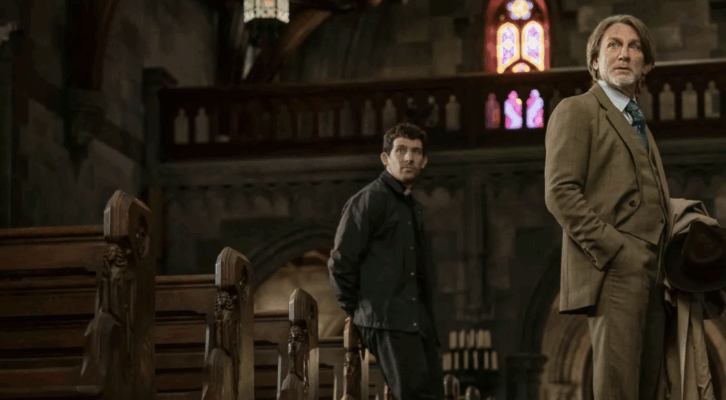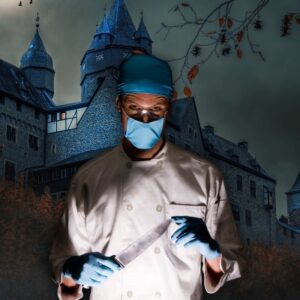In the spring of 1939, with the Japanese navy laying waste to Chinese ports and the surrounding seas lousy with pirates and torpedoes, the American travel writer Richard Halliburton decided to sail a custom-built Chinese junk from Hong Kong to San Francisco.
Outlandish as it sounds, it was on brand for Halliburton. He’d made a name for himself in the twenties and thirties risking life and limb in the name of romance and adventure.
He traveled in an open-cockpit airplane across the deserts of Africa and Asia. He climbed Mt. Fuji in the dead of winter. He swam the crocodile-infested waters of the Panama Canal. On Gibraltar, he’d been arrested for taking pictures of military installations. In Thailand, he was attacked by a cobra “in dramatic fashion.”
In the world of Richard Halliburton, everything happened “in dramatic fashion.” It’s what turned his travels into popular books and made him a fixture on the lecture circuit. It’s what carved a permanent place in the hearts of wanderlust-prone readers with titles like The Royal Road to Romance, The Glorious Adventure, The Flying Carpet, and his compendium of world wonders for young readers, Richard Halliburton’s Complete Book of Marvels.
It’s also what earned him the derision of certain critics and writers who deemed Halliburton’s prose purple and his hijinks manufactured. Hemingway once referred to him as the “Ladies Home Journal adventurer,” a dig not just at Halliburton’s middlebrow popularity (he indeed wrote several pieces for Ladies Home Journal) but also at his boyish-rather-than-manly persona and his not entirely concealed homosexuality.
Even at the height of his fame, in 1930, Vanity Fair awarded him the dubious honor of being among those “We Nominate for Oblivion.” Why? “Because Richard Halliburton has made a glorious racket out of Dauntless Youth; because his books are marvelously readable, transparently bogus, extremely popular, and have made their author a millionaire.”
So, in 1939, never one to let common sense or critics stand in the way of a good adventure— and with any luck, a good book— Halliburton staked it all on his Pacific voyage. He’d written several successful books by then, though never quite a good one. But he held out hope that this next book would be the one. He needed it to be.
The plan was simple: build a traditional Chinese wooden sailing ship, outfit it with an able crew, and sail it across the ocean for three months, from Victoria Harbor to the San Francisco Bay, arriving at Treasure Island to great fanfare for the 1939 Golden Gate International Exposition—a west coast world’s fair to celebrate the newly built Bay Bridge and Golden Gate Bridge and promote pan-Pacific Unity.
Of course, nothing went according to plan.
Halliburton, despite asking for a traditional junk, insisted that his Hong Kong shipbuilder install modern appurtenances, including a diesel engine, skylights, and mimeograph machine. The latter was needed for making thousands of copies of letters written aboard ship, which would be mailed at various ports of call to young readers who, in one of Halliburton’s diverse schemes to raise funds for the trip, had bought advance $5 subscriptions to his “Letters from the Sea Dragon.”
Before the ship set sail, a review by a respected merchant marine captain, Charles Jokstad, found numerous design flaws that seriously questioned the Sea Dragon’s seaworthiness. Among them, in addition to the skylights and heavy engine, was a poop deck raised eight feet above standard, which Halliburton had demanded to accommodate the huge ornamental dragons he had painted on the sides.
Subsequent modifications delayed the timeline and added to the soaring cost of the expedition. Halliburton had already over-leveraged himself and was on the verge of bankruptcy.
To make matters worse, he’d just built a gravity-defying and savings-draining modernist mansion, dubbed Hangover House, on the cliffs of Laguna Beach. He was counting on arriving at Treasure Island, where, as he repeatedly told himself and others, he would recoup his costs with profits from the Fair, offering junk tours and pleasure cruises around the bay.
On February 5, the Sea Dragon left the harbor to a fireworks-and-rice-wine send off and appeared to sail nimbly into the horizon. But only five days later, it was seen hobbling back to the marina. It had encountered a storm near Formosa, which caused hull leaks and multiple injuries among the crew—billed as “a rupture” and “appendicitis” in Halliburton’s official reports to the press.
In fact, as the diary of Sea Dragon captain John Welch reveals, the maladies were an outbreak of venereal disease—a “swollen nutsack” and “a nice little rose…of a chancre”—caught from the Hong Kong brothels and smuggled aboard.
Halliburton’s crew—which included two recent alumni of Dartmouth, a Julliard student who had never touched a sail, and Halliburton’s longtime partner and lover, the journalist Paul Mooney, equally lacking in sea legs— was now down two men due to “injuries.” And once they reached shore, more jumped ship.
Meanwhile, the writer-adventurer found himself back in his hotel by the Kowloon shipyard, bedridden with eczema, awaiting repairs and watching the grains of sand run out.
Halliburton must have been feeling especially trapped and desperate at that point in his life. Every minute he delayed his voyage, the deeper into debt he sank. And the later in the season he sailed, the more likely he would encounter ferocious, storm-tossed seas. But, even if his ship somehow remained intact and he financially afloat, there were other forms of shipwreck to worry about.
After years of playing the boyish wanderer, traipsing into danger in exotic locales and stumbling out with a droll story and a grin, Halliburton sensed he was reaching the end of his own royal road. Now pushing forty, how long could he don the Peter Pan suit?
He’d once referred to himself as “Don Quixote Jr.,” but how long could he inhabit the quixotic borderlands of the heroic and buffoonish before becoming simply a sad old man who’s lost his mind? How long could he range the world in the role of the dashing bachelor while keeping his own true identity and desires below deck?
Even in his twenties, with two best-selling books to his name, the young writer-adventurer sensed the walls of his newly constructed literary persona closing in. “I must stop glorifying myself,” he wrote to his parents. He dreamed instead of doing a serious book, without himself as the silly protagonist, something properly literary or historical that would earn him not just popular but critical acclaim.
But later in the same letter, he sprung the trap on himself: “I must fight an over-artistic conscience, and keep my faith in popularity and the value of romanticism….Once I get financial independence, I’ve literary independence too.”
The riches came, for a time, but not the independence. Instead, Halliburton had made a bespoke prison for himself in the popular adventure market, extolling the life untrammeled. And after an unsuccessful foray into movies in the early thirties, his adventures became increasingly contrived.
In 1935, following the footsteps of Hannibal, he attempted to cross the Alps on an elephant (whom he named Elysabethe Dalrymple). But Elizabeth was uncooperative—she spooked at the sound of car horns and her footpads blistered on the alpine terrain. Halliburton’s Rome remained unconquered.
“Much of the joyous wonder has gone out of my writings,” he confided in a letter from 1936. For his next adventure and book, he needed to strike a new tone, break out of the mold of his persona as the daring idiot and heroic buffoon. While waiting for his ship to be built, he even tried his hand at war correspondence, making visits to Canton and Shanghai to report on their devastation by the Japanese.
And yet, as evidenced by the leaky boat he was waiting to re-board, he was still stuck. Stuck in the same grooves cut by his twenty-four-year-old self. It seems telling that Halliburton’s projected next book bore the tentative title The Royal Road to Romance in America—a lame and uninspired-sounding sequel to his first book, The Royal Road to Romance.
When the Sea Dragon finally left Hong Kong on the second attempt, the voyage was more than a month behind schedule. Short on time, money, and an able crew, Halliburton skipped his originally intended ports of call at Manila and Wake Island and made a bee line for Midway.
After nearly three weeks of smooth sailing on open ocean, the ship hit a typhoon.
On March 24, 1939, the Sea Dragon sent a radio message to the nearby ocean liner SS Coolidge, some twelve hundred miles from Midway Island: “SOUTHERLY GALES RAIN SQUALLS LEE RAIL UNDER WATER WET BUNKS HARDTACK BULLY BEEF HAVING WONDERFUL TIME WISH YOU WERE HERE INSTEAD OF ME.”
It was the last anyone would ever hear from Richard Halliburton or any of the Sea Dragon’s crew.
But was it true? Was Halliburton really dead?
After all, he had pulled this kind of stunt before. In 1925, Halliburton, trying to generate publicity for his first book, had faked his own death while, in imitation of Byron, he swam the Hellespont. Though news of his drowning splashed across the pages of the New York Times, reporters eventually uncovered the ruse. As a result, the taint of phoniness, a crass showmanship bordering on con artistry, followed Halliburton throughout his career.
Perhaps that’s why the Navy waited two months before launching a desultory search-and-rescue mission. Also fresh in their memory, no doubt, were the fruitless attempts to find Amelia Earhart, whose plane had been lost in the Pacific not two years earlier.
In October 1939, with still no trace of the Sea Dragon or its crew, a Tennessee chancery court declared Halliburton officially dead, drowned somewhere near the International Dateline.
The legion of young subscribers to the voyage of the Sea Dragon never got their letters. The writer-adventurer’s mimeograph machine likely lies at the bottom of the ocean, thick with sea moss.
But while Halliburton faded from public memory with the onslaught of World War Two, his adventurous spirit lived on in readers’ minds, spurring their imagination. In the years following his disappearance, there were numerous supposed sightings of the wreckage of the Sea Dragon, along with speculation as to how the writer-adventurer met his end, if at all.
He had pulled this kind of stunt before. In 1925, Halliburton, trying to generate publicity for his first book, had faked his own death while, in imitation of Byron, he swam the Hellespont.Some said Halliburton was interned in a Japanese penal colony, awaiting decapitation. Others said he’d washed ashore on the phantom islands of Los Jardines.
One acquaintance even got word Richard Halliburton and Paul Mooney were both alive in Mexico, having made the Pacific crossing intact with a cargo of opium. In the fifties, sightings of Halliburton’s ghost surfaced, with the writer-adventurer haunting his custom-built house on the cliffs of Laguna Beach.
Inspired by the abiding mystery of Richard Halliburton’s life and disappearance, my new novel World Pacific takes up the ill-fated 1939 voyage of a writer-adventurer named Dicky Halifax and explores the question: What if he didn’t drown….?
***


















